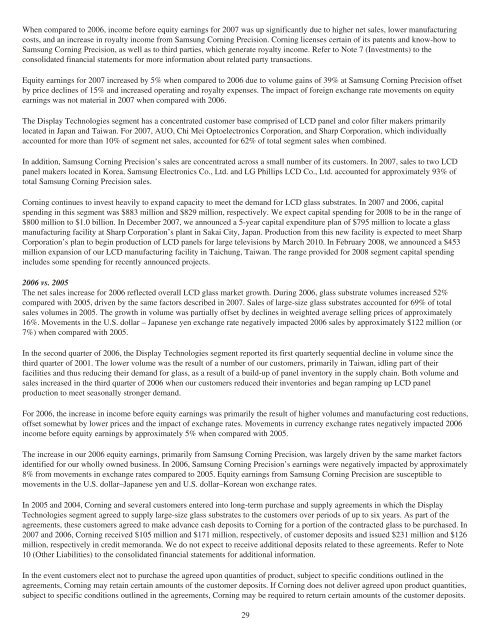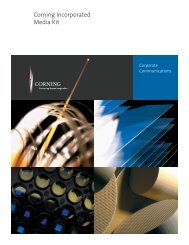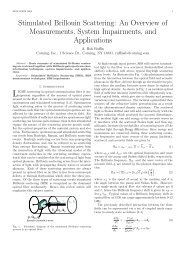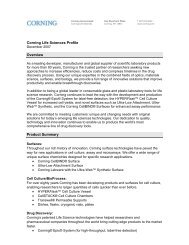You also want an ePaper? Increase the reach of your titles
YUMPU automatically turns print PDFs into web optimized ePapers that Google loves.
When compared to 2006, income before equity earnings for <strong>2007</strong> was up significantly due to higher net sales, lower manufacturing<br />
costs, and an increase in royalty income from Samsung <strong>Corning</strong> Precision. <strong>Corning</strong> licenses certain of its patents and know-how to<br />
Samsung <strong>Corning</strong> Precision, as well as to third parties, which generate royalty income. Refer to Note 7 (Investments) to the<br />
consolidated financial statements for more information about related party transactions.<br />
Equity earnings for <strong>2007</strong> increased by 5% when compared to 2006 due to volume gains of 39% at Samsung <strong>Corning</strong> Precision offset<br />
by price declines of 15% and increased operating and royalty expenses. The impact of foreign exchange rate movements on equity<br />
earnings was not material in <strong>2007</strong> when compared with 2006.<br />
The Display Technologies segment has a concentrated customer base comprised of LCD panel and color filter makers primarily<br />
located in Japan and Taiwan. For <strong>2007</strong>, AUO, Chi Mei Optoelectronics Corporation, and Sharp Corporation, which individually<br />
accounted for more than 10% of segment net sales, accounted for 62% of total segment sales when combined.<br />
In addition, Samsung <strong>Corning</strong> Precision’s sales are concentrated across a small number of its customers. In <strong>2007</strong>, sales to two LCD<br />
panel makers located in Korea, Samsung Electronics Co., Ltd. and LG Phillips LCD Co., Ltd. accounted for approximately 93% of<br />
total Samsung <strong>Corning</strong> Precision sales.<br />
<strong>Corning</strong> continues to invest heavily to expand capacity to meet the demand for LCD glass substrates. In <strong>2007</strong> and 2006, capital<br />
spending in this segment was $883 million and $829 million, respectively. We expect capital spending for 2008 to be in the range of<br />
$800 million to $1.0 billion. In December <strong>2007</strong>, we announced a 5-year capital expenditure plan of $795 million to locate a glass<br />
manufacturing facility at Sharp Corporation’s plant in Sakai City, Japan. Production from this new facility is expected to meet Sharp<br />
Corporation’s plan to begin production of LCD panels for large televisions by March 2010. In February 2008, we announced a $453<br />
million expansion of our LCD manufacturing facility in Taichung, Taiwan. The range provided for 2008 segment capital spending<br />
includes some spending for recently announced projects.<br />
2006 vs. 2005<br />
The net sales increase for 2006 reflected overall LCD glass market growth. During 2006, glass substrate volumes increased 52%<br />
compared with 2005, driven by the same factors described in <strong>2007</strong>. Sales of large-size glass substrates accounted for 69% of total<br />
sales volumes in 2005. The growth in volume was partially offset by declines in weighted average selling prices of approximately<br />
16%. Movements in the U.S. dollar – Japanese yen exchange rate negatively impacted 2006 sales by approximately $122 million (or<br />
7%) when compared with 2005.<br />
In the second quarter of 2006, the Display Technologies segment reported its first quarterly sequential decline in volume since the<br />
third quarter of 2001. The lower volume was the result of a number of our customers, primarily in Taiwan, idling part of their<br />
facilities and thus reducing their demand for glass, as a result of a build-up of panel inventory in the supply chain. Both volume and<br />
sales increased in the third quarter of 2006 when our customers reduced their inventories and began ramping up LCD panel<br />
production to meet seasonally stronger demand.<br />
For 2006, the increase in income before equity earnings was primarily the result of higher volumes and manufacturing cost reductions,<br />
offset somewhat by lower prices and the impact of exchange rates. Movements in currency exchange rates negatively impacted 2006<br />
income before equity earnings by approximately 5% when compared with 2005.<br />
The increase in our 2006 equity earnings, primarily from Samsung <strong>Corning</strong> Precision, was largely driven by the same market factors<br />
identified for our wholly owned business. In 2006, Samsung <strong>Corning</strong> Precision’s earnings were negatively impacted by approximately<br />
8% from movements in exchange rates compared to 2005. Equity earnings from Samsung <strong>Corning</strong> Precision are susceptible to<br />
movements in the U.S. dollar–Japanese yen and U.S. dollar–Korean won exchange rates.<br />
In 2005 and 2004, <strong>Corning</strong> and several customers entered into long-term purchase and supply agreements in which the Display<br />
Technologies segment agreed to supply large-size glass substrates to the customers over periods of up to six years. As part of the<br />
agreements, these customers agreed to make advance cash deposits to <strong>Corning</strong> for a portion of the contracted glass to be purchased. In<br />
<strong>2007</strong> and 2006, <strong>Corning</strong> received $105 million and $171 million, respectively, of customer deposits and issued $231 million and $126<br />
million, respectively in credit memoranda. We do not expect to receive additional deposits related to these agreements. Refer to Note<br />
10 (Other Liabilities) to the consolidated financial statements for additional information.<br />
In the event customers elect not to purchase the agreed upon quantities of product, subject to specific conditions outlined in the<br />
agreements, <strong>Corning</strong> may retain certain amounts of the customer deposits. If <strong>Corning</strong> does not deliver agreed upon product quantities,<br />
subject to specific conditions outlined in the agreements, <strong>Corning</strong> may be required to return certain amounts of the customer deposits.<br />
29







